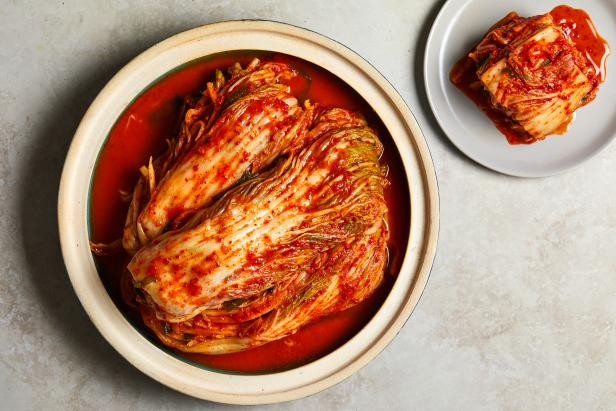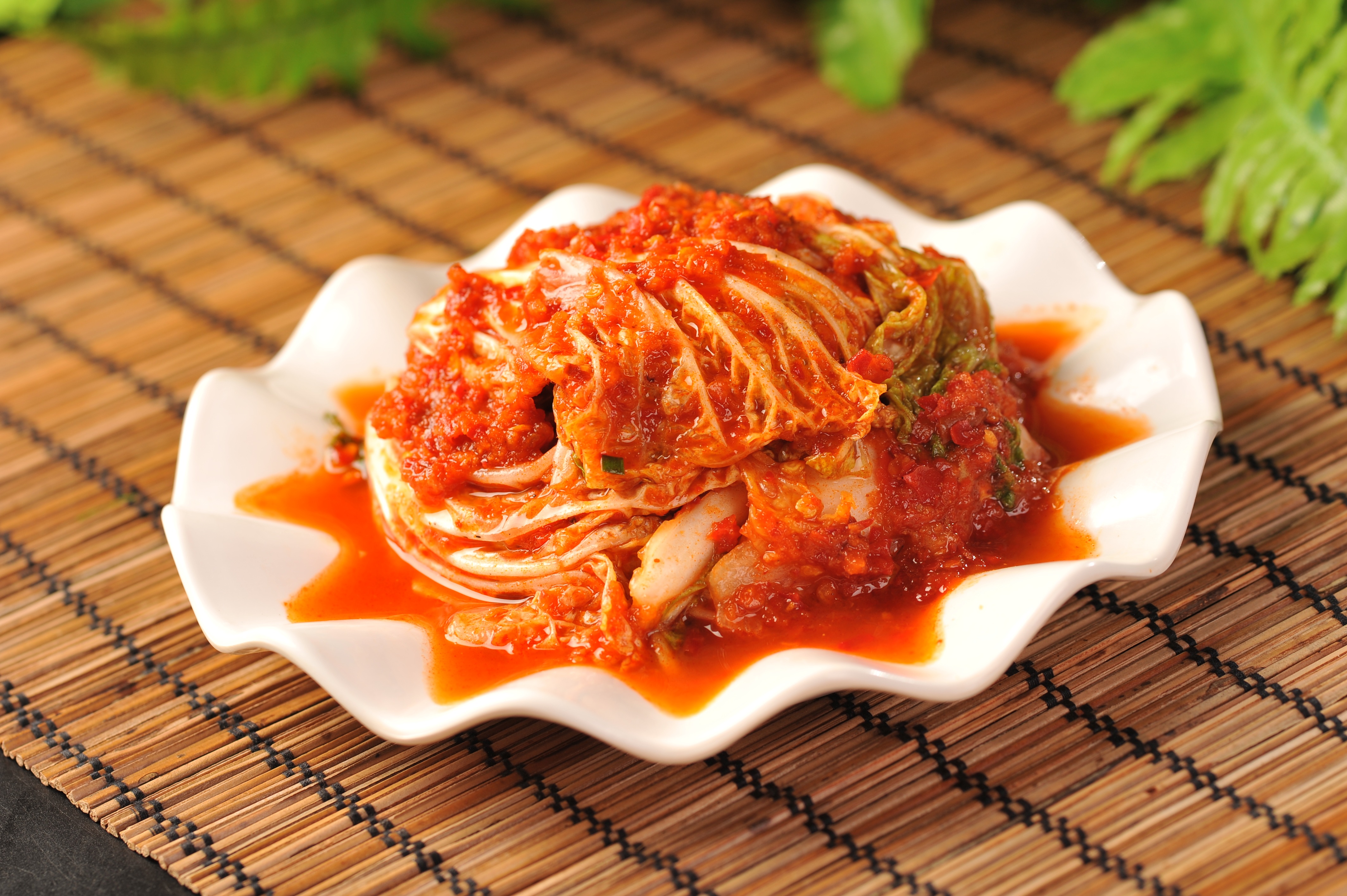ระเบียงภาพ [ แก้ ] 606
by Admin
Posted on 20-10-2023 02:44 PM

Afrikaans
العربية
অসমীয়া
فارسی
suomi
עברית
हिन्दी
ქართული
қазақша
ភាសាខ្មែរ
မြန်မာဘာသာ
nederlands
ئۇيغۇرچە / uyghurche
українська
ייִדיש
บทความ
อภิปราย
เครื่องมือ
เครื่องมือ
ย้ายเมนูไปที่แถบด้านข้าง
ซ่อน
อ่าน
ทั่วไป
หน้าที่ลิงก์มา
การเปลี่ยนแปลงที่เกี่ยวโยง
อัปโหลดไฟล์
หน้าพิเศษ
ลิงก์ถาวร
สารสนเทศหน้า
อ้างอิงบทความนี้
get shortened url
พิมพ์/ส่งออก
สร้างหนังสือ
ดาวน์โหลดเป็น pdf
รุ่นพร้อมพิมพ์
ในโครงการอื่น
วิกิมีเดียคอมมอนส์
วิกิตำรา
จากวิกิพีเดีย สารานุกรมเสรี
กิมจิ (คิมชี)
กิมจิร่วมสมัยรูปแบบต่าง ๆ
ชื่ออื่น
ฮันกึล
gimchi
kimch'i
ประเทศเกาหลี
กิมจิ ( เกาหลี : 김치; ราชบัณฑิตยสภา : คิมชี) เป็นของกินตามประเพณีใน อาหารเกาหลี ประกอบด้วย ผัก
เช่น
ผักกาดขาว และ หัวไชเท้า ที่หมักดองด้วยเกลือและเครื่องปรุงอื่น ๆ เช่น ผงพริกที่เรียก โกชูการู ต้นหอม กระเทียม ขิง และอาหารทะเลหมักเค็มที่เรียก ช็อตกัล มักรับประทานเป็น เครื่องเคียง แทบทุกมื้อ และมักใช้เป็นส่วนผสมในอาหารประเภทต้มและตุ๋น
กิมจินั้นมีหลายร้อยรูปแบบ ซึ่งทำด้วยผักที่ต่างกันออกไป ตามประเพณีแล้ว กิมจิมักเก็บไว้ในโอ่งดินขนาดใหญ่ที่เรียก องกี แล้วฝังไว้ใต้ดินเพื่อมิให้แข็งตัวในช่วงฤดูหนาว และเพื่อรักษาอุณหภูมิมิให้เน่าเปื่อยเร็วไปในช่วงฤดูร้อน โอ่งดังกล่าวบางทีก็เก็บไว้นอกบ้านตรงชานที่ทำขึ้นพิเศษ เรียกว่า ชังดกแด ส่วนในยุคปัจจุบัน หันไปใช้ ตู้แช่กิมจิ กันมากขึ้น
ระเบียงภาพ[ แก้ ]
กิมจิผักกาดขาว
คิมชีจีแก แกงทำจาก.

Etymology [ edit ]
Etymology[ edit ]
borrowed from korean 김치 (gimchi), ultimately composed within korea of chinese -derived morphemes 沉 (mc drim, “submerged, soaked”) and 菜 (mc tshojh, “vegetable”), i. E. "fermented vegetable".
 Doublet of kimuchi. Kimchi
kimchi (usually uncountable , plural kimchis )
a korean dish made of vegetables, such as cabbage or radishes, that are salted, seasoned, and stored in sealed containers to undergo lactic acid fermentation. , pocket books, page 238:
2007, pamela goyan kittler, kathryn sucher,
food
and culture
, cengage learning, page 5:
2011, gerald m. Weinberg,
cantonese: 泡菜 (paau3 coi3)
chinese:
nominative
possessive forms of kimchi (type risti)
first-person singular possessor
kimchi in wielki słownik języka polskiego, instytut języka polskiego pan
kimchi in polish dictionaries at pwn.
Doublet of kimuchi. Kimchi
kimchi (usually uncountable , plural kimchis )
a korean dish made of vegetables, such as cabbage or radishes, that are salted, seasoned, and stored in sealed containers to undergo lactic acid fermentation. , pocket books, page 238:
2007, pamela goyan kittler, kathryn sucher,
food
and culture
, cengage learning, page 5:
2011, gerald m. Weinberg,
cantonese: 泡菜 (paau3 coi3)
chinese:
nominative
possessive forms of kimchi (type risti)
first-person singular possessor
kimchi in wielki słownik języka polskiego, instytut języka polskiego pan
kimchi in polish dictionaries at pwn.
History [ edit ]
Fermentation has been part of human diet since the prehistoric times. Kimchi is a korean culinary tradition with a 1,500 year recorded history, developed as a means to preserve cabbage and other vegetables naturally through fermentation—like its distant cousin sauerkraut, or brined pickles. There is a certain mythical aura to kimchi if you ask any koreans. Long heralded as the “super food” of korea, many studies and findings in recent years associate kimchi’s unique attributes to numerous health benefits. Kimchi produces non-dairy probiotics, or “healthy bacteria,” that aids in digestion and building a healthy, balanced gut flora, which results in a stronger immune system .
Dishes usually served with kimchi [ edit ]
In korean culture, kimchi is served with almost every meal, including breakfast. Not only is kimchi eaten by itself as a side dish or appetizer but it is also used as an ingredient in a variety of dishes. Kimchi jjigae , a traditional stew made with kimchi, is perhaps one of its most popular uses. The fermented food is also used to flavor fried rice, stir-fry dishes, noodles, sandwiches, and even pizza.
Miriam hahn/tasting table before you get started, you must make a list and head to the store. Pick up napa cabbage, pink himalayan salt, filtered water, carrots, radishes, scallions, grated ginger , minced garlic, fish sauce, red pepper flakes , and sugar. In addition to the foods, you'll also need supplies for the fermenting process. In this case, hahn notes that you'll need a 32-ounce mason jar, a wooden mallet, and a glass sauerkraut weight. She admits it's possible to get by without the specialized tools — for instance, if you don't have the sauerkraut weight, you can get away with using a large leaf of cabbage reserved from the head of cabbage you're fermenting — but says if you want to make kimchi regularly, it's best to invest in the appropriate fermenting tools.
Traditionally, kimchi is made from cabbage. But a wide variety of vegetables can stand in for or be combined with this leafy green, from carrots to radishes to cucumbers. Some kimchi recipes include fish or meat for an added oomph as a main dish, while water kimchi is a soup-like version served in broth. The only real “requirement” for kimchi is a base of fermented vegetables. If you try making kimchi, experiment with recipes that use alternative veggies, spices, or other additions.
Kimchee is a traditional korean dish of fermented vegetables, the most common of which are napa cabbage and daikon radish. Kimchee is actually the national food of korea. And, it should be noted that the proper spelling of kimchi is “kimchee. ” in this post, i occasionally refer to it as kimchi, but that is the japanese spelling for this beloved korean dish. In addition to being served as banchan, korean side dishes presented as part of a meal, it can also be used in a variety of cooked dishes like kimchi fried rice or kimchi quesadillas. I love topping these korean (bulgogi) beef tacos with it – they’re amazingly delicious!.